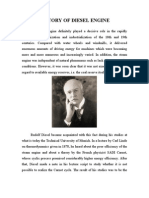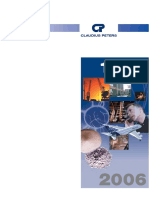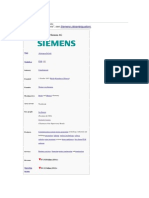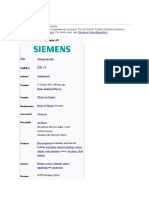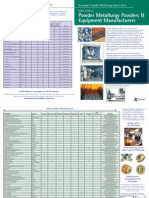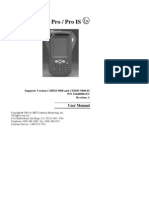Achieving Technical Milestones: Continuity and Change During 175 Years of Sulzer
Achieving Technical Milestones: Continuity and Change During 175 Years of Sulzer
Uploaded by
Reza KurniawanCopyright:
Available Formats
Achieving Technical Milestones: Continuity and Change During 175 Years of Sulzer
Achieving Technical Milestones: Continuity and Change During 175 Years of Sulzer
Uploaded by
Reza KurniawanOriginal Description:
Original Title
Copyright
Available Formats
Share this document
Did you find this document useful?
Is this content inappropriate?
Copyright:
Available Formats
Achieving Technical Milestones: Continuity and Change During 175 Years of Sulzer
Achieving Technical Milestones: Continuity and Change During 175 Years of Sulzer
Uploaded by
Reza KurniawanCopyright:
Available Formats
ANNIVERSARY ISSUE
Continuity and change during 175 years of Sulzer
Achieving technical milestones
Sulzer has made a number of important contributions to technical progress over the last 175 years. The company became known globally for its steam engines and diesel engines. While the nature of its activities has changed over the years, qualities such as reliability, innovation, and a global perspective still form the basis of its success today.
The founders of the company, Johann Jakob Sulzer-Hirzel (18061883) and Salomon Sulzer-Sulzer (18091869).
ulzer was founded in 1834 by the brothers Johann Jakob SulzerHirzel (18061883) and Salomon Sulzer-Sulzer (18091869), as well as their father Johann Jakob Sulzer-Neuffert (17821853). The company began as a cast iron foundry on the outskirts of Winterthur, which was still a small town at the time. The workshop initially employed two skilled craftsmen and two day laborers. While the father continued to focus on traditional brass casting, the sons turned their attention to the manufacturing of cast iron using progressive techniques that they had learned during their apprenticeships abroad. Pumps, presses, and various forms of machinery used in the textile industry were among their first products. From the outset, quality was assigned the highest priority at Sulzer. The company was soon able to capitalize on the growth of the textile and machine industry in the Canton of Zurich, as well as in Eastern Switzerland and the neighboring regions. While the expensive brass casting business dwin-
dled, the demand for cast iron products soared and enabled the newly established company to expand rapidly.
Steam engine drives growth
Sulzer reached an important turning point in 1851. At the time, the company already had around 100 employees working in well-equipped iron and boiler foundries but it had not yet developed into an engineering works. Running the company was consuming so much of the Sulzer brother's time that it was hampering the development of new products. The hiring of the talented young English design engineer Charles Brownwhose son later went on to establish Brown Boveri (now ABB)proved fortuitous for the company. Brown developed groundbreaking new steam engines for Sulzer that were of decisive importance for the advancement of the company. He was a brilliant designer who was always full of new ideas but had little interest in the financial success of his work. Johann Jakob Sulzer-Hirzel's talents as an entrepreneur and salesman and Charles
Brown's expertise as an inventor and engineer thus proved a winning combination over a period of two decades. The first Sulzer steam engine left the workshop in 1854. This successful product was followed by the first-ever horizontal valve-fitted steam engine in 1867. During the same year, Sulzer began to manufacture passenger ships. It also continued to develop its traditional manufacturing lines such as pumps and presses, steam heating systems, and equipment and machinery for the textile industry.
From a small company of craftsmen to an industrial firm
From 1851 to 1870, the number of employees increased tenfold to 1 000 and Sulzer finally made the transition from a small company of craftsmen to an industrial firm. It also increasingly ventured into foreign markets. In 1881, Sulzer opened its first foreign branch in Ludwigshafen in Germany and further expanded its global presence through licenses, its own sales offices, and independent agencies.
32 | Sulzer Technical Review 2+3/2009
4274
175 YEARS OF SULZER
The Sulzer brothers also played a pioneering role as responsible employers. Sulzer has always recognized that highly qualified employees are the company's most valuable asset. Considerable importance was therefore assigned to internal and external training from an early stage. In addition, the company lent its support to the foundation of the first Swiss technical school in Winterthur in 1874. Commencing in the 1870s, Sulzer also began to build houses in order to provide affordable homes for its employees.
Sulzer diesel engine takes its place in world history
The steam engine was the driving force behind the industrial revolution. However, it had reached its limits by the late 19th century in view of its substantial maintenance costs and its less than 10% efficiency. The inventor Rudolf Diesel (18581913) therefore began designing a new combustion engine as an alternative to the steam engine, and it was patented in 1892. The following year, Sulzer obtained the license for Switzerland and,
in 1903, obtained the rights to build and sell this new type of engine outside of Switzerland. Led by Johann Jakob Sulzer-Imhoof (18551922), the son of its founder Salomon Sulzer-Sulzer, the company focused intensively on developing the new type of engine for practical applications. In 1897, the first 20 hp four-stroke diesel engine underwent testing at Sulzer and the company produced its first diesel engines in 1903. With an efficiency of over 25%, this diesel engine was superior to all other thermal engines available at the time. This breakthrough marked the beginning of a period of constant technical advancement that would translate into a major success story. The range of uses of the diesel engine rapidly expanded from stationary equipment for the generation of electricity to inland water vessels. The maiden voyage of the Monte Penedo part of the Hamburg Sd shipping line on the route from Hamburg to Rio Grande do Sul in Brazil in 1912 represented another milestone. This cargo ship, which was fitted with two two-stroke
An early Sulzer diesel engine with 120 hp, fabricated for the cement factory Walenstadt in 1904.
diesel engines, was the forerunner of all of today's ocean liners.
Continuity and change
The broad range of activities that Sulzer was engaged in during the 19th century increased even more significantly during the 20th century. Thanks to its own innovative strength in the field of technology, as well as a number of acquisitions, Sulzer positioned itself as a leading man-
The groundbreaking Sulzer steam engine in a sales brochure from 1880.
Sulzer Technical Review 2+3/2009 | 33
ANNIVERSARY ISSUE
Casting, since 1834 Hydroelectric power, 18402000 Heating and building services, 18412001 Steam boilers, 18411993 Steam engines, 18541952 Centrifugal pumps, since 1857 Steamships, 18671934 Refrigeration, 18772001 Piping and vessels, 18771994 Reciprocating compressors, 18782002 Diesel engines, 18971989 Steam turbines, 19031963 Locomotives, 19061998 Turbocompressors, 19061998 Heat pumps, 19382001 Waste combustion plants, 19411994 Gas turbines, 19472001 Projectile weaving and other textile machines, 19522002 Nuclear technology/valves for nuclear power plants, 19531997 Vacuum columns, since 1959 Medtech, 19622001 Paper machines and Nipco rolls 1968-1997 Static mixers, since 1972 Surface technology, since 1985 Turbomachinery service, since 1990 Fuel cell systems, 19972005 Mixing and cartridge technology since 2006 Mist eliminators since 2006 Process technology since 2009 1830 1850 1870 1890 1910 1930 1950 1970 1990 2009
Key activities of Sulzer since 1834.
ufacturer of locomotives, compressors, textile machines, and numerous other products. However, the company streamlined its activities towards the end of the 20th century. Several fields of business were discontinued entirely but most were merged with the operations of other companies and still exist today outside Sulzer .
The company currently consists of four divisions: Sulzer Pumps, Sulzer Metco, Sulzer Chemtech, and Sulzer Turbo Services. Sulzer has been developing and producing centrifugal pumps since 1857 and is thus one of the world's oldest pump manufacturers. It knew how to help shape technical developments and to
continuously find new applications for its pumpsranging from irrigation plants in the 19th century to pumps for the extraction, transportation, and refinement of oil and gas that dominate the product range of Sulzer Pumps today. At the end of the 1950s, Sulzer began producing internal components for separation columns. Static mixers, separation technology, and process technology are now part of the broad range of offerings supplied by Sulzer Chemtechparticularly for the hydrocarbon processing industry. Commencing in 1985, Sulzer made a series of acquisitions that enabled Sulzer Metco to secure a leading position in the surface technology sector. Sulzer Turbo Services, which is today one of the largest independent providers of maintenance and repair services for thermal turbo machinery, originated from Sulzer's former turbine construction business.
Ready for the future
From the industrial revolution of the 19th century to the modern knowledge-based society of the 21st century, the nature of technological challenges has altered dramatically. Sulzer has always succeeded in adapting to changing market conditions by continuously creating innovative, high-quality products that reflect the company's reputation for excellence.
Bernhard Ruetz Director of the Verein fr wirtschaftshistorische Studien, which conducts research into economic history Publisher of Schweizer Pioniere der Wirtschaft und Technik (Swiss Pioneers of Business and Technology) Vogelsangstrasse 52 8006 Zrich Switzerland
Since 1857 Sulzer develops and produces centrifugal pumps.
The history of the founding of Sulzer is the topic of Volume 40 of the Schweizer Pioniere der Wirtschaft und Technik (Swiss Pioneers of Business and Technology) series, which was published in 2000. Volume 40 can be ordered at no charge at news@sulzer.com (only available in German).
34 | Sulzer Technical Review 2+3/2009
You might also like
- Goldhofer ChronicleDocument25 pagesGoldhofer ChronicleStefanos TzortzisNo ratings yet
- Introduction To Cad/Cam Using MastercamDocument29 pagesIntroduction To Cad/Cam Using MastercammangulupradhanNo ratings yet
- Assignment 2Document4 pagesAssignment 2Rizwan HaidarNo ratings yet
- Colonel Alan Brooke Pemberton & Diversified Corporate Services Limited - MI6 Front Companies in GermanyDocument26 pagesColonel Alan Brooke Pemberton & Diversified Corporate Services Limited - MI6 Front Companies in GermanyAlan Pemberton - DCSNo ratings yet
- Yarn Faults and ClearingDocument8 pagesYarn Faults and Clearingsitu_tex8594100% (7)
- "Informal Institutions Rule" Williamson Article ReviewDocument2 pages"Informal Institutions Rule" Williamson Article ReviewSamy Hamdane100% (1)
- ABC Catalog Part9 Geschiedenis ABCDocument4 pagesABC Catalog Part9 Geschiedenis ABCYves DelandmeterNo ratings yet
- 02 History of Diesel EngineDocument5 pages02 History of Diesel EnginePreetham NagendranNo ratings yet
- Claudius PetersDocument8 pagesClaudius PetersFarid AhmedNo ratings yet
- CH1 - Aircraft Diesel EngDocument8 pagesCH1 - Aircraft Diesel EngPJGD100% (1)
- En - Welger HistoryDocument4 pagesEn - Welger HistoryEmilian Icleanu100% (1)
- 100 Years of Ammonia Synthesis Technology: Ib DybkjærDocument10 pages100 Years of Ammonia Synthesis Technology: Ib DybkjærGrootNo ratings yet
- The Foundation Rigs Are Sorted by ManufacterDocument3 pagesThe Foundation Rigs Are Sorted by ManufacterBinh le ThanhNo ratings yet
- Atlas CopcoDocument12 pagesAtlas CopcoMAQUINARIAPESADA100% (1)
- ( Zi Mɛns) Multinational Conglomerate Munich: Siemens AG (Document5 pages( Zi Mɛns) Multinational Conglomerate Munich: Siemens AG (Gaurav ChaurasiaNo ratings yet
- Diesel EnginesDocument23 pagesDiesel EnginesSanket BalapurkarNo ratings yet
- SiemensDocument17 pagesSiemenspipi_spinettaNo ratings yet
- What Is The Meaning of Diesel EngineDocument31 pagesWhat Is The Meaning of Diesel EngineaguzkupridNo ratings yet
- Porting and Cylinder ScavengingDocument2 pagesPorting and Cylinder Scavenging69x4No ratings yet
- JDN ImageDocument13 pagesJDN ImageTh NattapongNo ratings yet
- History of Pump IndustryDocument18 pagesHistory of Pump IndustrySampath Kumar100% (1)
- Amp LintecDocument24 pagesAmp Lintecdk_moehammed100% (2)
- Histoy of KKK 20080623184356 1 FileDocument17 pagesHistoy of KKK 20080623184356 1 FileMarcioNo ratings yet
- A Brief History of PumpsDocument6 pagesA Brief History of PumpsChristian Vargas100% (1)
- Presentación 1Document35 pagesPresentación 1antoniodemoraNo ratings yet
- Schindler HistoryDocument7 pagesSchindler HistoryJose Daniel De la CruzNo ratings yet
- DPW DG43 Sulzer Diesel EnglDocument35 pagesDPW DG43 Sulzer Diesel Englvenkat praveenNo ratings yet
- Diesel LocomotivesDocument1 pageDiesel Locomotives0amit099No ratings yet
- Atlas Copco 140 YearsDocument136 pagesAtlas Copco 140 YearsJulliana SilvaNo ratings yet
- Diesel EngineDocument29 pagesDiesel EngineRavi KumarNo ratings yet
- SiemensDocument29 pagesSiemensMaria AndreeaNo ratings yet
- Anglų Kalbos: Kauno Technikos Kolegija Elektromechanikos FakultetasDocument6 pagesAnglų Kalbos: Kauno Technikos Kolegija Elektromechanikos FakultetasGintaras ČiegisNo ratings yet
- Rudolf Diesel UkkkkkkkkkkkkkkkkkkkDocument7 pagesRudolf Diesel UkkkkkkkkkkkkkkkkkkkUday KiranNo ratings yet
- Diesel EngineDocument32 pagesDiesel Enginerobinson respiciusNo ratings yet
- BUSINESS History of ShellDocument2 pagesBUSINESS History of ShellLakmus6No ratings yet
- The Success of ShellDocument12 pagesThe Success of ShellAyezza Margarette BaranganNo ratings yet
- Mar Pow PPT Presentation Group 2Document11 pagesMar Pow PPT Presentation Group 2Jose Vian Alix BagcatNo ratings yet
- History ProjectDocument14 pagesHistory Projectvaghelashweta92No ratings yet
- A. Lange & Sohne Company HistoryDocument2 pagesA. Lange & Sohne Company HistoryshlomomizrNo ratings yet
- The 'Success' of The Combined Cycle Gas TurbineDocument6 pagesThe 'Success' of The Combined Cycle Gas TurbineNada Hasan100% (1)
- Rudolf DieselDocument2 pagesRudolf DieselMisc BagNo ratings yet
- Factsheet Turbine Assembly Hall BerlinDocument3 pagesFactsheet Turbine Assembly Hall BerlinelinsbotNo ratings yet
- Rudolf Christian Karl Diesel Is His Real NameDocument6 pagesRudolf Christian Karl Diesel Is His Real NameAbirami SanmugumNo ratings yet
- Difference Between Industrial Revolution & French, Russian Revolution?Document10 pagesDifference Between Industrial Revolution & French, Russian Revolution?Anonymous 3owUL0ksVNo ratings yet
- The Second Industrial RevolutionDocument15 pagesThe Second Industrial Revolutionzacksantella50% (2)
- Brouchure Man MuseumDocument16 pagesBrouchure Man MuseumRover DmsNo ratings yet
- From Gunpowder To Pit Viper tcm1240-3515532 PDFDocument8 pagesFrom Gunpowder To Pit Viper tcm1240-3515532 PDFTati Jacome100% (1)
- Documentation The Silos BaselDocument14 pagesDocumentation The Silos BaselAousten AAtenNo ratings yet
- Gas Turbine HistoryDocument6 pagesGas Turbine Historyzhd_shah100% (2)
- Heinrich Stoll - Founder of The CompanyDocument2 pagesHeinrich Stoll - Founder of The CompanyMohammad RezaNo ratings yet
- Components of Diesel Generator in BriefDocument100 pagesComponents of Diesel Generator in BriefHarish Padmanaban100% (1)
- Your Partner For Pumping Solutions: PumpsDocument44 pagesYour Partner For Pumping Solutions: Pumpszhigang dingNo ratings yet
- Crude IdeasDocument1 pageCrude Ideasakhaling96No ratings yet
- Shell Story2004Document33 pagesShell Story2004Davi BaetaNo ratings yet
- Tutima Catalog 2020-1Document112 pagesTutima Catalog 2020-1lpstutterheimNo ratings yet
- Diesel EngineDocument32 pagesDiesel EngineWira SentanuNo ratings yet
- Car HistoryDocument7 pagesCar HistoryAhmad FikriNo ratings yet
- TOEC Profile 2010Document38 pagesTOEC Profile 2010sdojklcmlNo ratings yet
- Hand-Book of Millwork For Contractors 1926Document87 pagesHand-Book of Millwork For Contractors 1926Ted Haigh100% (1)
- Company Brochure DFE EnglishDocument10 pagesCompany Brochure DFE EnglishSaurabh JajuNo ratings yet
- (C) (F) Metals and Metal Alloys Plain Carbon and Low Alloy SteelsDocument4 pages(C) (F) Metals and Metal Alloys Plain Carbon and Low Alloy SteelsReza KurniawanNo ratings yet
- Powder Metallurgy Powders & Equipment ManufacturersDocument2 pagesPowder Metallurgy Powders & Equipment ManufacturersReza KurniawanNo ratings yet
- Working Plan: NO Urutan Kerja Alat Potong VC N A FZ F VFDocument1 pageWorking Plan: NO Urutan Kerja Alat Potong VC N A FZ F VFReza KurniawanNo ratings yet
- Bottle Caps: 1. Process of ManufacturingDocument5 pagesBottle Caps: 1. Process of ManufacturingReza KurniawanNo ratings yet
- Promaster Tough Setting GuideDocument14 pagesPromaster Tough Setting Guidemeor3705No ratings yet
- Mmu - Ic.polyu - Edu.hk Handout 0102 0102Document10 pagesMmu - Ic.polyu - Edu.hk Handout 0102 0102VivekanandankNo ratings yet
- Business Improvement Proposal by Fiona PDFDocument26 pagesBusiness Improvement Proposal by Fiona PDFChollada TontanasutthivongNo ratings yet
- Nursing Informatics: Instructor: Ms. Cherry B. BoctotoDocument68 pagesNursing Informatics: Instructor: Ms. Cherry B. BoctotoRegibel Torres100% (1)
- UntitledDocument135 pagesUntitled9 TNo ratings yet
- Thiesclima - Wind Display LED - 30 05 2023Document3 pagesThiesclima - Wind Display LED - 30 05 2023Роман КарпенкоNo ratings yet
- Ua5000 Ipmsan NGN Service ConfigurationDocument21 pagesUa5000 Ipmsan NGN Service ConfigurationHudzrul NizamNo ratings yet
- DBMS Interview QuestionsDocument18 pagesDBMS Interview QuestionsviswasknitNo ratings yet
- Fair Phyllis The Blue Bird PDFDocument1 pageFair Phyllis The Blue Bird PDFMattNo ratings yet
- DraughtDocument33 pagesDraughtNipun SabharwalNo ratings yet
- Project OS2Document2 pagesProject OS2smily ranaNo ratings yet
- Hab TishDocument36 pagesHab TishHabtamu LemaNo ratings yet
- Eprs Step by Step Instructions PDFDocument27 pagesEprs Step by Step Instructions PDFHelen Santos PadillaNo ratings yet
- Juj 103 - Literasi KomputerDocument8 pagesJuj 103 - Literasi KomputerAdnnyl NnymNo ratings yet
- Arduino NanoDocument11 pagesArduino Nanohira khanNo ratings yet
- Common Threads: Awk by Example, Part 3: Ibm Developerworks Linux Linux ArticlesDocument8 pagesCommon Threads: Awk by Example, Part 3: Ibm Developerworks Linux Linux ArticlesSeth4ChaosNo ratings yet
- Paternity Benefit: Employed, Your Employer Must Complete This Form To Certify You AreDocument2 pagesPaternity Benefit: Employed, Your Employer Must Complete This Form To Certify You AreBahia El RefaiNo ratings yet
- Motor Electrico ABB 4 KWDocument1 pageMotor Electrico ABB 4 KWAlvaro Reimar Ferrufino MartinezNo ratings yet
- A Monorail Is A RailDocument2 pagesA Monorail Is A Railemo_aziNo ratings yet
- Q Slope Mobile Phone App ManualDocument16 pagesQ Slope Mobile Phone App ManualShakeel AhmadNo ratings yet
- 2 Stroke Petrol EngineDocument9 pages2 Stroke Petrol EnginePurushotham PulivarthiNo ratings yet
- Volume-3 Davr PDFDocument213 pagesVolume-3 Davr PDFNaresh PattanaikNo ratings yet
- Pasteurizer Recorder and Recorder Controller: C1950 (STLR & HTST)Document8 pagesPasteurizer Recorder and Recorder Controller: C1950 (STLR & HTST)Mer ryNo ratings yet
- Mattie Heffron: - Fashion Merchandising-Objective EducationDocument1 pageMattie Heffron: - Fashion Merchandising-Objective Educationapi-365143520No ratings yet
- Marlin ManualDocument158 pagesMarlin Manualklivekar100% (2)
- Energy Efficiency Electronic Book Version 1548 - PowerGenerationHandbook v1 - 1Document362 pagesEnergy Efficiency Electronic Book Version 1548 - PowerGenerationHandbook v1 - 1avikrisadNo ratings yet







